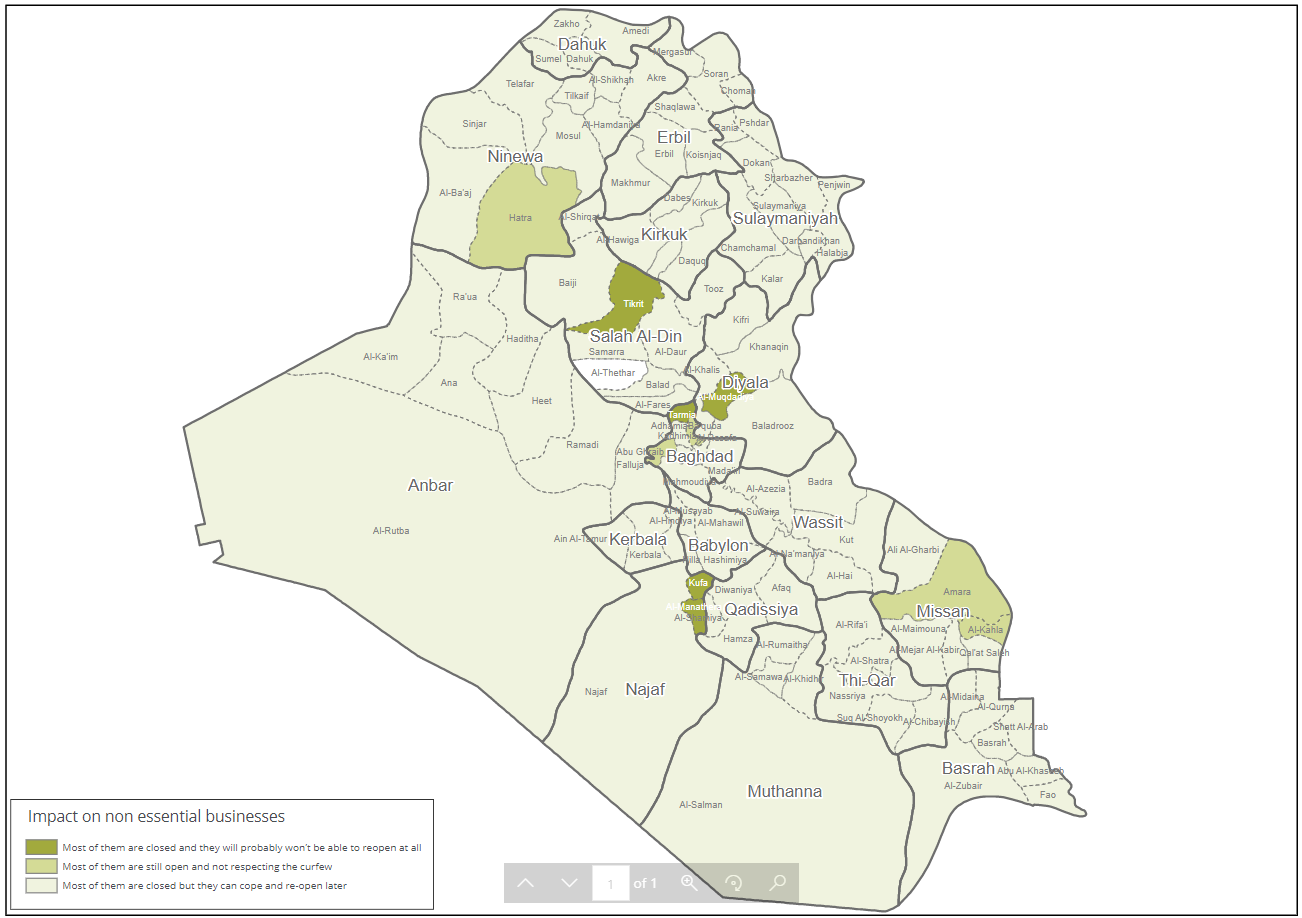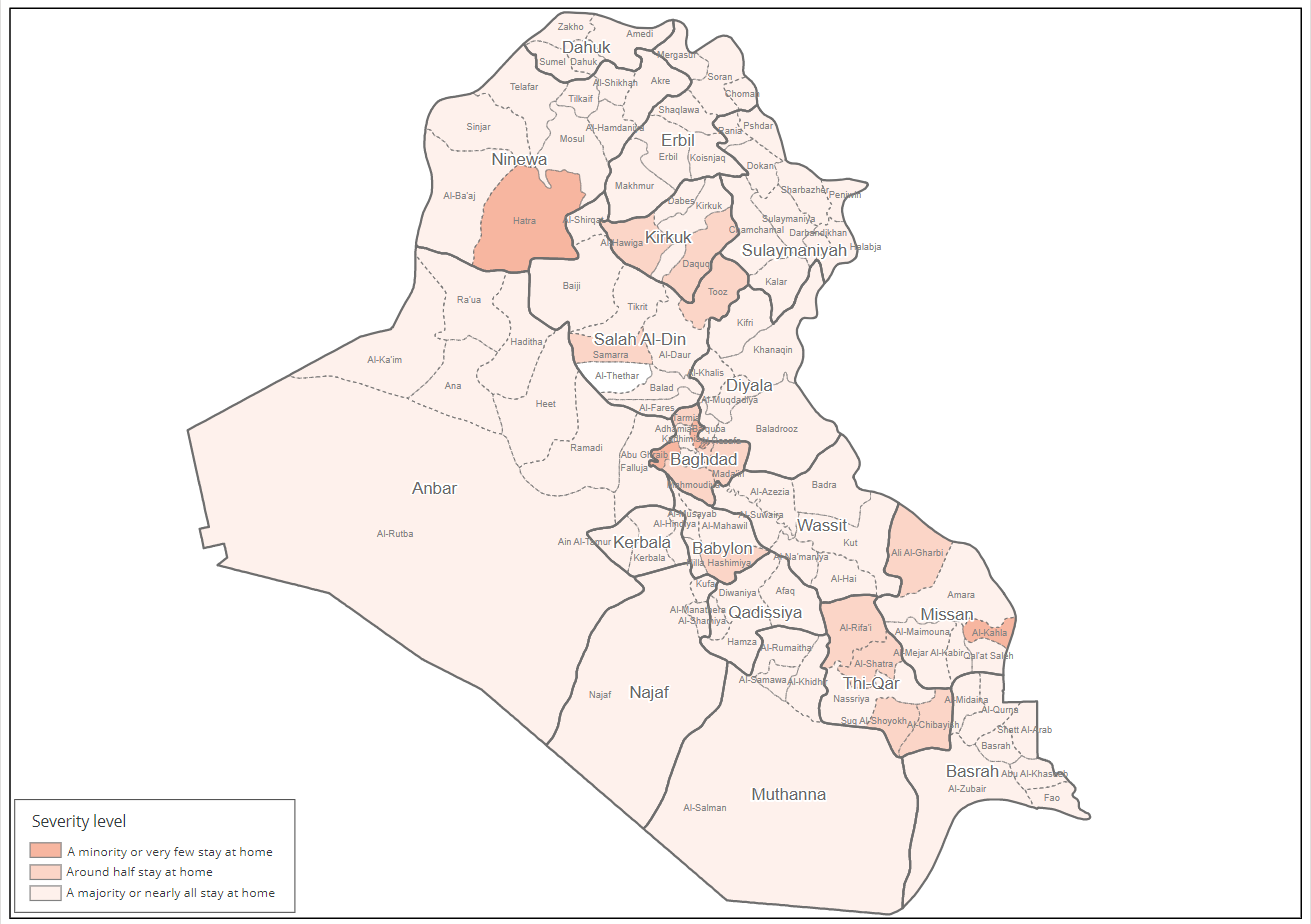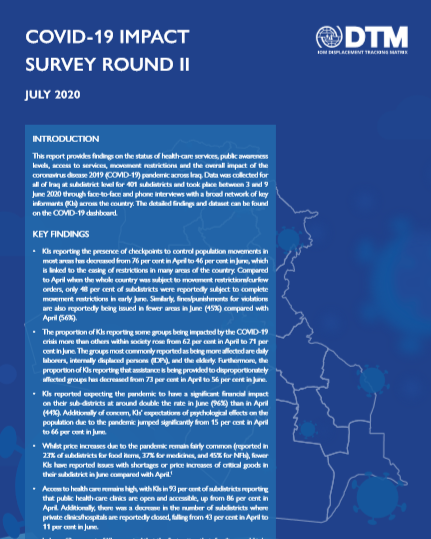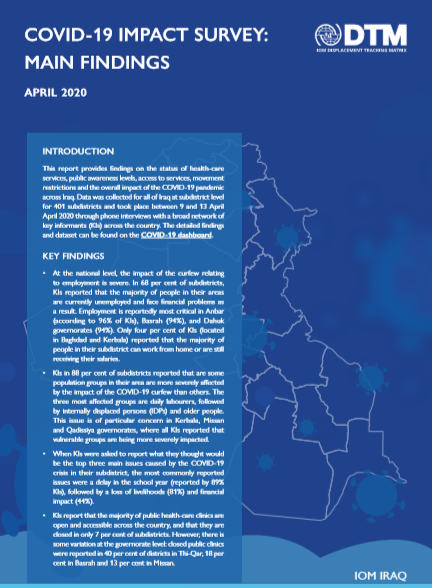Vulnerable groups
At the national level, the situation of employment is severe. In 68 per cent of subdistricts, KIs reported that the majority of people in their areas have lost their jobs and face financial problems as a result. Employment is reportedly most critical in Anbar (according to 96% of KIs), Basrah (94%), and Dahuk (94%). Only 4 per cent of KIs (located in Baghdad and Kerbala) reported that the majority of people in their subdistrict can work from home or are still receiving their salaries. Map 1 below shows level of impact.

KIs in the majority of subdistricts (90%) felt that even though non-essential businesses are currently closed, they will be able to re-open once the curfew has been lifted, which shows strong potential for businesses to bounce back. However, the situation in Najaf is reportedly worse than in the rest of the country: in Najaf, 50 per cent of KIs reported that non-essential businesses might not be able to reopen after the curfew. Map 2 below shows the governorates that would be most affected.

KIs in 88 per cent of subdistricts reported that some population groups in their area are more severely affected by the impact of the COVID-19 curfew than others. The three most affected groups are daily labourers, followed by IDPs and older people. This issue is of particular concern in Kerbala, Missan and Qadissiya, where all KIs reported that vulnerable groups are being more severely impacted. In 73 per cent of subdistricts, however, KIs reported that provisions are being made to assist the most severely affected groups. The host community reportedly contributes the most to this assistance, followed by non-governmental institutions and religious entities.
When KIs were asked to report what they thought would be the top three main issues that the COVID-19 crisis would cause in their subdistricts, the most commonly reported issues were a delay in the school year (reported by 89% of KIs), followed by a loss of livelihoods (81%) and a negative financial impact (44%).
Services, facilities and goods
Findings confirm that following governmental orders, schools and most government services are closed throughout the country. Psychosocial support services are also largely closed or otherwise unavailable. Banks, markets, pharmacies and supermarkets continue to operate normally or with reduced hours. Other services such as garbage collection, desludging, electricity and water continue to be provided normally, with garbage collection being the most impacted service. KIs in 77 per cent of subdistricts reported garbage collection to be normal, whilst KIs in 21 per cent of subdistricts reported that this service is operating less frequently than normal, and in 2 per cent there was no collection at all, highlighting a potential public health issue. Baghdad, Najaf, and Kirkuk appear to be the most affected governorates, with 8 per cent, 8 per cent, and 6 per cent of KIs respectively reporting that garbage collection has stopped in their subdistrict.
A composite index was developed to determine the level of provision for all assessed facilities (pharmacies, schools, supermarkets/grocery stores, functioning markets, psychosocial support services, banks/financial institutions, government services) at the governorate level. For this index, ‘all’ constitutes seven out of seven facilities, ‘most’ constitutes four or more out of seven facilities and ‘half or less’ constitutes fewer than four of the facilities.
When examining this index, substantial variations in the level of provision across the governorates become evident. Babylon and Sulaymaniyah have witnessed the least impact on the provision of facilities, with half or more of all services continuing to function. Muthanna and Qadissiya witnessed the greatest level of impact, with KIs in the vast majority of areas showing that most facilities are closed. Diyala is the only governorate were KIs in some subdistricts reported that all facilities are closed.

KIs in 69 per cent of subdistricts reported that there had been price increases and/or shortages of essential goods in their subdistrict since the crisis began. Price increases have been a prevailing challenge, with 41 per cent of KIs reporting that they had occurred, and an additional 22 per cent reporting that there had been both price increases and shortages of goods in their subdistrict.
Healthcare provision and practices
The findings from this analysis show that the majority of public health-care clinics are open and accessible across the country, and that they are closed in only 7 per cent of subdistricts. However, there is some variation at the governorate level: closed public clinics were reported in 40 per cent of districts in Thi Qar, 18 per cent in Basrah and 13 per cent in Missan. These results show that residents of these governorates may have greater difficulty accessing health-care services when needed. Private clinics and hospitals are much less accessible at the national level, as they are reportedly closed in 43 per cent of subdistricts. While 45 per cent of KIs reported that there are no public hospitals in their subdistricts, in almost all of the remaining subdistricts, public hospitals are reportedly open and accessible.
A composite index was developed to examine the overall accessibility of health-care facilities, including public health-care clinics, public hospitals and private clinics/hospitals. While there are a few subdistricts where KIs reported that all facilities are closed – in 6 per cent of subdistricts in Kirkuk, Dahuk and Basrah, 4 per cent in Anbar and 3 per cent in Erbil – or that there are no facilities at all in some subdistricts (in Ninewa and Diyala), there is significant variation in the proportion of KIs reporting that all facilities are open. In Babylon and Sulaymaniyah in particular, there may be some difficulty in accessing health-care services as evidenced by the high prevalence of reports that some healthcare facilities are closed in the majority of subdistricts. Contrarily, data from Muthanna, Qadissiya and Missan indicate that the vast majority of health-care facilities remain open, meaning that in these governorates, access is likely good.

Public awareness levels of the COVID-19 pandemic appear to be strong, with public awareness materials distributed widely at the national level: 96 per cent of KIs reported this to be the case in their subdistricts. Similarly, KIs felt that the information provided has been adequate and people in their subdistricts have enough information about the pandemic (reported by 98% of KIs). In Najaf, the distribution of public awareness materials has been much lower than elsewhere in the country, with 50 per cent of KIs reporting that there has been no distribution of public awareness materials in their subdistrict. Despite this lack of material, KIs reported that still good information is available throughout the governorate.
In the event that someone in the KI’s family or community experienced symptoms of COVID-19, the vast majority of KIs reported that they and the people in their subdistrict would seek medical attention. At the national level, KIs reported that in 56 per cent of subdistricts the procedure would be to go to a public health facility, in 38 per cent to call the information hotline, and in 2 per cent to go to a private clinic or hospital. KIs in only four per cent of locations reported that in their subdistrict, symptomatic people would stay at home and wait for symptoms to either improve or deteriorate before seeking medical advice. KIs in Dahuk (100%), Najaf (75%), and Erbil (73%) were the most likely to report that the first action of symptomatic people would be to call the hotline and ask for advice.
KIs in most subdistricts reported that people are aware that quarantine is needed in the event that the virus has been contracted – in 78 per cent of subdistricts it was reported that people would quarantine in a designated facility within the subdistrict, in 15 percent they would quarantine outside the subdistrict, and in 7 per cent they would quarantine at home.
Movement restrictions
Government-enforced curfews seem to be well respected across the country, with KIs in 76 per cent of all subdistricts reporting that the majority of people stay at home and respect the curfew. However, in some governorates the curfew orders are not being respected; this is a particular concern in Baghdad, where KIs in only 15 per cent of subdistricts reported that the majority respect the curfew and stay home, as well as in Thi-Qar (20%) and in Missan (47%).
Checkpoints, controls and patrols have been implemented across most of the country, with KIs in 76 per cent of subdistricts reporting that these measures are being implemented in their areas. However, fines or punishments for breaking the curfew are much less commonly implemented – these were reported in only 56 per cent of subdistricts nationwide.

While the findings of this assessment are indicative, there is a correlation between the reported enforcement of fines/ punishment for breaking the curfew and the reported level of respect for the curfew orders. Where fines/punishment are more commonly reported by KIs, people are reportedly more likely to stay at home. Where no fines/punishments are reported, a minority of people reportedly stay at home (25%); where fines/ punishments are enforced in some areas, around half of people reportedly remain at home (50%); and in areas where fines are commonly reported, the majority of people (75 per cent or more) reportedly stay at home.
The data for round one of this COVID-19 dashboard was collected between 9-13 April, and round two between 3-9 June 2020. The information is collected at subdistrict level and covers 401 sub-districts across Iraq (2 sub-districts were non-assessable). Data was collected through IOM’s Rapid Assessment and Response Teams (RARTs), composed of over 100 staff members deployed across Iraq (20% of enumerators are female). IOM’s RARTs collect data through interviews with key informants utilizing a large, well-established network that includes community leaders, mukhtars, local authorities and security forces. The key informants’ responses to the questions asked aim to represent the actual situation across the sub-district, and are not based on their opinions, unless phrased otherwise. Whenever possible, triangulation of findings was conducted with more than one key informant per sub-district. Due to movement restrictions related to COVID-19, data was collected through a combination of phone and face-to-face interviews
The aim of the assessment is to give a comprehensive picture of the status of healthcare services, public awareness levels, access to services, movement restrictions and the overall impact of the pandemic across all governorates of Iraq. The tool used to gather this information was developed in close collaboration with the Assessment Working Group (AWG), which includes the Health Cluster and other key health actors.
| GOVERNORATE | NO. OF KIS INTERVIEWED |
|---|---|
| Anbar | 25 |
| Babylon | 16 |
| Baghdad | 40 |
| Basrah | 17 |
| Dahuk | 17 |
| Diyala | 26 |
| Erbil | 37 |
| Kerbala | 7 |
| Kirkuk | 16 |
| Missan | 15 |
| Muthanna | 13 |
| Najaf | 12 |
| Ninewa | 37 |
| Qadissiya | 15 |
| Salah al-Din | 19 |
| Sulaymaniyah | 52 |
| Thi-Qar | 20 |
| Wassit | 17 |
| Total interviews | 401 |

